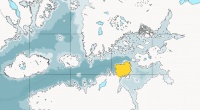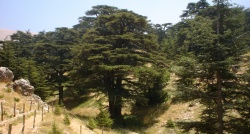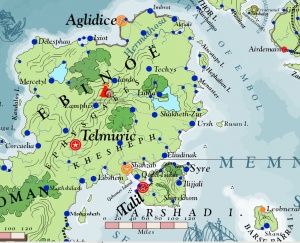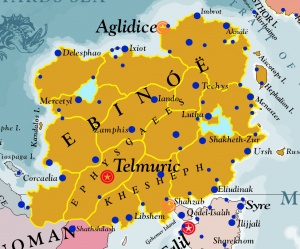Difference between revisions of "Ambrinqua"
Trismegistus (talk | contribs) m (add flag image) |
Trismegistus (talk | contribs) |
||
| (22 intermediate revisions by the same user not shown) | |||
| Line 1: | Line 1: | ||
| + | [[File:MapLocatorAmbrinqua.jpg|thumb|200px|Locator Map showing the Ambrinquan Peninsula in relationship to the [[Greater Pallathantic]]]] | ||
| + | |||
The ancient land of Ambrinqua, once a bevy of provinces in the [[Yophenthean Empire]], is now the last remnant of the [[Gorcorumbese Empire of the Ephysgæes]]. Ambrinqua is thus a geographic term and not political. The human subjects of Ebinóë to the northwest and Khesheph to the southeast wish their nations to be free of the Gorcorumbese Geddamin and free of each other as well. The gradual yet irresistible decline and dismantling of the Gorcorumbese Empire hold out the prospect that these last countries nestled below the [[Ephysgæe Mountains]] will someday obtain their independence as [[Narshad]] and [[Jerushabla]] already have. Although Ambrinqua is physically attached to [[Danona]], culturally it is attached to the neighboring nations and peoples of the Pallathantic, especially [[Corundy]] to the east and northwestern [[Weshif]] across the [[Memnosian Sea]]. | The ancient land of Ambrinqua, once a bevy of provinces in the [[Yophenthean Empire]], is now the last remnant of the [[Gorcorumbese Empire of the Ephysgæes]]. Ambrinqua is thus a geographic term and not political. The human subjects of Ebinóë to the northwest and Khesheph to the southeast wish their nations to be free of the Gorcorumbese Geddamin and free of each other as well. The gradual yet irresistible decline and dismantling of the Gorcorumbese Empire hold out the prospect that these last countries nestled below the [[Ephysgæe Mountains]] will someday obtain their independence as [[Narshad]] and [[Jerushabla]] already have. Although Ambrinqua is physically attached to [[Danona]], culturally it is attached to the neighboring nations and peoples of the Pallathantic, especially [[Corundy]] to the east and northwestern [[Weshif]] across the [[Memnosian Sea]]. | ||
| Line 4: | Line 6: | ||
=Inhabitants= | =Inhabitants= | ||
| − | Humans and Geddamin are the most populous humanlike inhabitants of Ambrinqua. Halfling settlements are uncommon but not unknown. On occasion, Bovitaurs ( | + | Humans and Geddamin are the most populous humanlike inhabitants of Ambrinqua. Halfling settlements are uncommon but not unknown. On occasion, Bovitaurs ([[bucentaurs]] and [[minotaurs]]), [[beastfolk]], and [[satyr]]s make their way into southwestern Ambrinqua until the humans or giants drive them out. Of the humans, the largest groups are the Ebinóëse to the north and the Cospians to the south. |
=Climate and Flora= | =Climate and Flora= | ||
| − | Northern Ambrinqua or [[Ebinóë]] has a Pallathantic Climate with moderately warm summers and occasional rains and a cool very rainy winter. Southern Ambrinqua or [[Khesheph]] has a Memnosian Climate characterized by a long, hot, and dry summer, and cool, rainy winter. The two islands of Narshad off the coast of Khesheph enjoy similar weather with slightly more rain. The [[Ephysgæe Mountains]] run from the southwest of the peninsula nearly to the northeast. They are formed by volcanic lift and there is one semi-dormant volcano in their midst. These mountains catch much of the rain that comes from the north, ensuring that Ebinóë has lush woods of cypresses, boxwoods, oaks, bay laurels, Judas Trees, Cork Oaks, and stone pines where human encroachment has let them grow wild. Elsewhere in Ebinóë are cultivated olive orchards, fig orchards, and vineyards that produce excellent wines. The Ephysgæes themselves bear Ebinóëse pines and Grey Elms. Khesheph also has woodlands of cypress and pines and vineyards, but they are not so riotous due to less rainfall. The higher regions less soiled by human settlement bear great Cospian Cedars. Cospian farms cultivate olives, | + | Northern Ambrinqua or [[Ebinóë]] has a Pallathantic Climate with moderately warm summers and occasional rains and a cool very rainy winter. Southern Ambrinqua or [[Khesheph]] has a Memnosian Climate characterized by a long, hot, and dry summer, and cool, rainy winter. The two islands of Narshad off the coast of Khesheph enjoy similar weather with slightly more rain. The [[Ephysgæe Mountains]] run from the southwest of the peninsula nearly to the northeast. They are formed by volcanic lift and there is one semi-dormant volcano in their midst. These mountains catch much of the rain that comes from the north, ensuring that Ebinóë has lush woods of cypresses, boxwoods, oaks, bay laurels, Judas Trees, Cork Oaks, and stone pines where human encroachment has let them grow wild. Elsewhere in Ebinóë are cultivated olive orchards, fig orchards, and vineyards that produce excellent wines. The Ephysgæes themselves bear Ebinóëse pines and Grey Elms. Khesheph also has woodlands of cedars, cypress and pines and vineyards, but they are not so riotous due to less rainfall. The higher regions less soiled by human settlement bear great Cospian Cedars. Cospian farms cultivate olives, vineyards, lemon orchards, and almonds. |
==Cospian Cedar== | ==Cospian Cedar== | ||
| − | The [[Cospian Cedar]] is very similar in size and appearance to Cedars of Lebanon on Earth. These trees were hewn down since ancient times to | + | {{Main|Cospian Cedar}} |
| + | [[File:LebanonCedarForest.jpg|thumb|250px|Forest of Cospian Cedars in [[Khesheph]] ]] | ||
| + | The [[Cospian Cedar]] is very similar in size and appearance to Cedars of Lebanon on Earth. These trees were hewn down since ancient times to construct fine palaces and temples. Some of their groves are considered sacred to the gods. Today only a few great woods of Cospian Cedars survive, hugging the south slopes of the Ephysgæe Mountains. They are jealously guarded by the Geddamin who love to use the wood to build the interiors of their great domo palaces in [[Shaprashilara Lum]]. Even the eleven foot high (3.25m) Geddamin are dwarfed by the mighty Cedars. | ||
=Politics= | =Politics= | ||
| − | [[File:Gorcorumb 2746_Political_001.jpg|thumb|300px|Map of Gorcorumbese Empire of the Ephysgæes]] | + | [[File:Gorcorumb 2746_Political_001.jpg|thumb|300px|Map of Gorcorumbese Empire of the Ephysgæes, showing the fourteen eparchies.]] |
| − | Ambrinqua is geographically synonymous with | + | Ambrinqua is geographically synonymous with the Gorcorumbese Empire. The Empire is divided into fourteen eparchies, each controlled by a harmost (governor) installed by the ruling house of Gorcorumb which holds the [[Anaxy]]. The coastal islands are subject to the provincial government of the nearby mainland. Revolutionaries would like to see Gorcorumb reduced to four core territories of the Ephysgæe Mountains and the liberation of the ten other eparchies, six to create the free state of [[Ebinóë]] and four to create [[Khesheph]]. The ruling Geddamin are clear that they have no intentions of further dismantling their empire and argue that such notions of liberation are based on human prejudice to Geddamin giants, not against foreign rule. They cite the vast empire of [[Aurician Empire|Aurice]] and [[Empire of Magdala|Magdala]] as examples of humans subject to foreign dominion and non-humans subject to humans. |
| − | In Gorcorumb, structures made of sandstone and other minerals rest at the base of the [[Ephysgæe]] Mountains and are home to the domo palaces of the ruling Gorcorumbese Nobles. In appearance, they resemble the towering mountains of Meteora on Earth in northern Greece. | + | In Gorcorumb, natural magdeologic structures made of sandstone and other minerals rest at the base of the [[Ephysgæe]] Mountains and are home to the domo palaces of the ruling Gorcorumbese Nobles. In appearance, they resemble the towering mountains of Meteora on Earth in northern Greece. |
=Languages of Ambrinqua= | =Languages of Ambrinqua= | ||
| − | There are three dominant language families spoken in Ambrinqua: [[Ebinóëse|Ebinóëse Language]], [[ | + | {{See also|Ambrinquan Language|Ebinóëse Language|Gorcorumbese Language|Cospian Language}} |
| + | There are three dominant language families spoken in Ambrinqua: [[Ebinóëse|Ebinóëse Language]], [[Gorcorumbese Language|Gorcorumbese]], and [[Thammazic Languages|Thammazic]] in Khesheph and the Narsadese Republic. Some scholars believe the [[Gorcorumbese Language|Gorcorumbese]] descended from the ancient Titanic language. [[Ebinóëse Language|Ebinóëse]] comes from the Ithatian language to which it is closely related, and [[Cospian Language|Cospian]] is related to Khahonri spoken in Jerushabla and Oliblish. In Narshad and its satellite islands, the Narsadese Language is spoken which is closely related to Cospian. During the Middle Ages, the Erechórambic language [[Ambrinquan Language|Ambrinquan]] (Early Ambrinquan, 1100 to 1400; Middle Ambrinquan, 1400 to 2000), was spoken among the descendants of Yophentheans and their human subjects. Ambrinquan is now extinct and only studied by scholars and linguists. There is another Gorcorumbese Language spoken by the giants who were awoken from the [[kumenontli]]. It is not well understood by human scholars and believed to be antediluvian. | ||
[[File:OverlordshipofGorcorumb_2740_Flag_001.jpg|thumb|300px|Flag of the Overlordship of Gorcorumb]] | [[File:OverlordshipofGorcorumb_2740_Flag_001.jpg|thumb|300px|Flag of the Overlordship of Gorcorumb]] | ||
=See Also= | =See Also= | ||
| + | <div style="column-count:2;-moz-column-count:2;-webkit-column-count:2"> | ||
*[[Ambrinquan Language]] | *[[Ambrinquan Language]] | ||
*[[Cospian Language]] | *[[Cospian Language]] | ||
*[[Danona]] | *[[Danona]] | ||
*[[Dragoman]] | *[[Dragoman]] | ||
| − | *[[ | + | *[[Ebinóë]] |
| − | *[[ | + | *[[Gorcorumbese Language]] |
*[[Gorcorumbese Empire of the Ephysgæes]] | *[[Gorcorumbese Empire of the Ephysgæes]] | ||
*[[Jerushabla]] | *[[Jerushabla]] | ||
| Line 36: | Line 42: | ||
*[[Thammazic Languages]] | *[[Thammazic Languages]] | ||
*[[Thyria]] | *[[Thyria]] | ||
| + | </div> | ||
{{Regions of Asdar}} | {{Regions of Asdar}} | ||
[[Category:Atlas]] | [[Category:Atlas]] | ||
{{stub}} | {{stub}} | ||
Latest revision as of 14:54, 18 November 2024

The ancient land of Ambrinqua, once a bevy of provinces in the Yophenthean Empire, is now the last remnant of the Gorcorumbese Empire of the Ephysgæes. Ambrinqua is thus a geographic term and not political. The human subjects of Ebinóë to the northwest and Khesheph to the southeast wish their nations to be free of the Gorcorumbese Geddamin and free of each other as well. The gradual yet irresistible decline and dismantling of the Gorcorumbese Empire hold out the prospect that these last countries nestled below the Ephysgæe Mountains will someday obtain their independence as Narshad and Jerushabla already have. Although Ambrinqua is physically attached to Danona, culturally it is attached to the neighboring nations and peoples of the Pallathantic, especially Corundy to the east and northwestern Weshif across the Memnosian Sea.
Inhabitants
Humans and Geddamin are the most populous humanlike inhabitants of Ambrinqua. Halfling settlements are uncommon but not unknown. On occasion, Bovitaurs (bucentaurs and minotaurs), beastfolk, and satyrs make their way into southwestern Ambrinqua until the humans or giants drive them out. Of the humans, the largest groups are the Ebinóëse to the north and the Cospians to the south.
Climate and Flora
Northern Ambrinqua or Ebinóë has a Pallathantic Climate with moderately warm summers and occasional rains and a cool very rainy winter. Southern Ambrinqua or Khesheph has a Memnosian Climate characterized by a long, hot, and dry summer, and cool, rainy winter. The two islands of Narshad off the coast of Khesheph enjoy similar weather with slightly more rain. The Ephysgæe Mountains run from the southwest of the peninsula nearly to the northeast. They are formed by volcanic lift and there is one semi-dormant volcano in their midst. These mountains catch much of the rain that comes from the north, ensuring that Ebinóë has lush woods of cypresses, boxwoods, oaks, bay laurels, Judas Trees, Cork Oaks, and stone pines where human encroachment has let them grow wild. Elsewhere in Ebinóë are cultivated olive orchards, fig orchards, and vineyards that produce excellent wines. The Ephysgæes themselves bear Ebinóëse pines and Grey Elms. Khesheph also has woodlands of cedars, cypress and pines and vineyards, but they are not so riotous due to less rainfall. The higher regions less soiled by human settlement bear great Cospian Cedars. Cospian farms cultivate olives, vineyards, lemon orchards, and almonds.
Cospian Cedar

The Cospian Cedar is very similar in size and appearance to Cedars of Lebanon on Earth. These trees were hewn down since ancient times to construct fine palaces and temples. Some of their groves are considered sacred to the gods. Today only a few great woods of Cospian Cedars survive, hugging the south slopes of the Ephysgæe Mountains. They are jealously guarded by the Geddamin who love to use the wood to build the interiors of their great domo palaces in Shaprashilara Lum. Even the eleven foot high (3.25m) Geddamin are dwarfed by the mighty Cedars.
Politics
Ambrinqua is geographically synonymous with the Gorcorumbese Empire. The Empire is divided into fourteen eparchies, each controlled by a harmost (governor) installed by the ruling house of Gorcorumb which holds the Anaxy. The coastal islands are subject to the provincial government of the nearby mainland. Revolutionaries would like to see Gorcorumb reduced to four core territories of the Ephysgæe Mountains and the liberation of the ten other eparchies, six to create the free state of Ebinóë and four to create Khesheph. The ruling Geddamin are clear that they have no intentions of further dismantling their empire and argue that such notions of liberation are based on human prejudice to Geddamin giants, not against foreign rule. They cite the vast empire of Aurice and Magdala as examples of humans subject to foreign dominion and non-humans subject to humans.
In Gorcorumb, natural magdeologic structures made of sandstone and other minerals rest at the base of the Ephysgæe Mountains and are home to the domo palaces of the ruling Gorcorumbese Nobles. In appearance, they resemble the towering mountains of Meteora on Earth in northern Greece.
Languages of Ambrinqua
There are three dominant language families spoken in Ambrinqua: Ebinóëse Language, Gorcorumbese, and Thammazic in Khesheph and the Narsadese Republic. Some scholars believe the Gorcorumbese descended from the ancient Titanic language. Ebinóëse comes from the Ithatian language to which it is closely related, and Cospian is related to Khahonri spoken in Jerushabla and Oliblish. In Narshad and its satellite islands, the Narsadese Language is spoken which is closely related to Cospian. During the Middle Ages, the Erechórambic language Ambrinquan (Early Ambrinquan, 1100 to 1400; Middle Ambrinquan, 1400 to 2000), was spoken among the descendants of Yophentheans and their human subjects. Ambrinquan is now extinct and only studied by scholars and linguists. There is another Gorcorumbese Language spoken by the giants who were awoken from the kumenontli. It is not well understood by human scholars and believed to be antediluvian.
See Also
| This article is a stub. It requires further development by the creator. |


